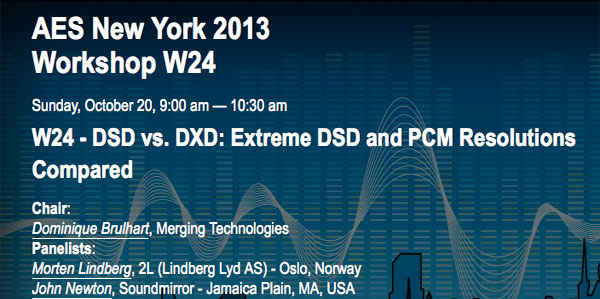Upcoming AES
I’m a member of the Audio Engineering Society. I think I’ve been a member for over 25 years or something like that. Going to the AES convention in San Francisco or Los Angeles was always a treat. When I was a newbie, I would cruise through the exhibits grabbing literature and talking to the sales type hawking their latest consoles or signal processors. Going through the stacks of glossy brochures was a serious part of my education. I remember spending hours reading the blurbs and trying to figure out the signal flow of the block diagrams. As I got older, I would meet friends in the aisles of the show…sometimes classmates from school and other times celebrities like Alan Parsons. In the recent past, I’d get invited to participate on a panel or as in the case of the Latin American AES convention; I provided the keynote address…that was fun.
So while I’m not going to make it to the 135th International AES Convention in New York next month, I have been following some of the news and information about the panels that will be happening. Morten Lynberg, the owner and engineer at 2L Records in Norway, posted a link to a session that he’s part of entitled, “DSD vs. DXD: Extreme DSD and PCM Resolution Compared”. The chair of the panel is a person from Merging Technologies, a company that is heavily behind high-end audio recording systems in both DSD and DXD, named Dominique Brulhart. Joining Morten on the panel will be John Newton from Soundmirror, a very well respected recording/mastering facility specializing in classical music.
This is a session that I would very much like to attend. In fact, I would like to participate on the panel because I fear that the presentation will elevate the “Extreme DSD” format unfairly. It would be great to have a frank and open discussion of the formats but without a strong advocate for HD PCM, the outcome is probably a foregone conclusion.
Why do I say that? Here are a couple of reasons.
I found this on the About Us page of the Sound Mirror website:
“Newton worked for four years with Sony and Philips in the development of the SACD, a high definition multi-channel format with greatly improved resolution, three dimensional sound, and clarity far beyond that of traditional compact discs.”
Once again, a statement that makes a statement that stretches the truth…a lot. The DSD 64 format gives you about the same frequency response as a traditional PCM CD. The noise rises quickly above 20-25 kHz…not far beyond what Redbook CDs can achieve. The “greatly improved resolution” also fails the smell test. The dynamic range of a CD is above 90 dB SNR and the dynamic range of an SACD is about the same “in band”. Then they really show their hand by saying “three dimensional sound, and clarity far beyond that of traditional compact discs”. Perhaps they’re bragging about the surround capabilities of SACD. However, the clarity adjective doesn’t fly.
I know Morten uses DXD during his source recordings and then converts to DSD or PCM for delivery. He just sent me a link to a new project that I will post on the iTrax.com website soon. However, it seems to me that the continuing use of the acronym DXD is a deliberate attempt to distance that format (which isn’t really a format at all but simply HD PCM) from PCM. The title of the session does parse correctly. It says DSD vs. DXD: Extreme DSD and PCM Resolutions Compared, which does tie DXD to PCM. So there’s hope.
The one file that I’ve downloaded in DXD format didn’t actually look like PCM to me…it was full of HF noise in my spectragraph, but I’m hold off any posts or comments until I see some additional examples.
I’m sorry I will miss this session…I hope they will record it.


Hi Mark,
I agree with your that “DXD format didn’t actually look like PCM to me”. I have observed the same high frequency noise bearing the signature of DSD in the DXD files I downloaded from 2L (http://www.2l.no/hires/index.html). By the way, did you have a chance to look at the various spectrograms of “Jimmy And The Crows” DSD file converted to PCM at http://leblogdejn.wordpress.com/spectrum/ ? It tends to indicate that the shape of the high frequency spectra is attributable to the LPF filter used to convert DSD to PCM.
Cheers,
JN